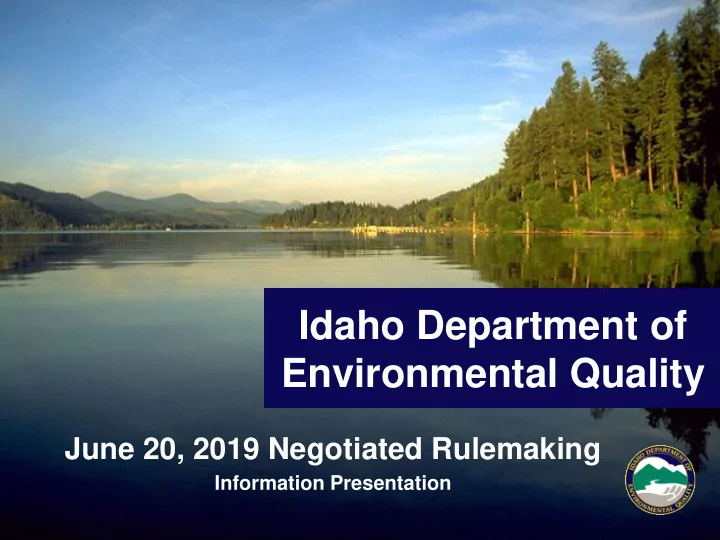

Idaho Department of Environmental Quality June 20, 2019 Negotiated Rulemaking Information Presentation
Agenda Review Why are we here? Guiding Principles What’s Been Covered Finish Framework Development Remaining Concepts Discussions Schedule Next Meeting Idaho Department of Environmental Quality
Why are we here? • IDAPA 58.01.01.614.02.b “The Department will develop and put into effect a Smoke Management Plan for Prescribed Burning consistent with the purpose of Section 600 through 614” • The use of prescribed fire is increasing nationally and in Idaho • County Commissioners and citizens in many parts of Idaho report concerns about the health impact caused from prescribed fire smoke. • Competition within an airshed – ag burning, smoke from other states, woodstove use, tribes, small burners that aren’t currently accounted for • Need year-round smoke management program Idaho Department of Environmental Quality
Guiding Principles for Rulemaking • Protect public health • Year round system and account for all prescribed burners • Meet elements of a smoke management program – Reduce the amount of emissions – Minimize the impacts from smoke from prescribed burning – Protect public health – Regional Haze and Exceptional Event Policy Criteria – Program Evaluation Idaho Department of Environmental Quality
Guiding Principles for Rulemaking • Incorporate basic smoke management practices – Evaluate smoke dispersion conditions to minimize smoke impacts – Monitor effects of prescribed fire on air quality – Record-keeping of prescribed fire activity and smoke behavior – Communication – public notification – Consider use of emission reduction techniques – Share the airshed Idaho Department of Environmental Quality
Smoke Management Program • Rules • Operating guide Idaho Department of Environmental Quality
Summary of Concepts So Far • Yearly registration of burners • Leverage the Airshed Group where possible • Tiered levels of burner • Move to a year round program including all prescribed burners • Smoke management training for burners • Requirements in rule, implementation in operating guide • Advisory committee to guide program operation and evaluation • State smoke clearance Idaho Department of Environmental Quality
Delineation of Burner Types • Major Burner – Burn more than 2,250 tons material per year • Minor Burner – Burn less than 2,250 tons material per year – Burn Category 1 • More than 100 tons material per day – Burn Category 2 • Between 2 and 100 tons material per day – Burn Category 3 • Less than 2 tons material per day Idaho Department of Environmental Quality
Minor Burners • Does not meet definition of Major Burner • These burners don’t burn frequently throughout the year • Can burn large amount in a single day • 3 categories of requirements based on size of individual burn (emissions) at a single site in a 24 hour period Idaho Department of Environmental Quality
Minor Burner General Requirements • Complete DEQ Smoke Management Training every 5 years • Burn only with DEQ smoke clearance Idaho Department of Environmental Quality
Minor Burner – Burn Category 1 • Register individual burn • Request to burn business day prior • Burn with DEQ smoke clearance • Request local weather forecast related to smoke dispersion • Person responsible for burn to verify and record weather conditions prior to ignition • Monitor smoke dispersion • Report accomplishments to DEQ Idaho Department of Environmental Quality
Minor Burner – Burn Category 2 • Request to burn one business day prior • Burn on designated smoke clearance day • Monitor smoke dispersion • Report accomplishments to DEQ Idaho Department of Environmental Quality
Minor Burners – Burn Category 3 • Follow smoke approvals on DEQ Open Burning Map • Encourage use of best smoke management practices Idaho Department of Environmental Quality
DEQ Smoke Clearance Process Major, Minor Category 1 & 2 • Protection of the NAAQS by evaluating the following: • Current and forecasted • Duration of burn air quality • Expected Emissions • Proximity to other burns • Meteorological Conditions • Acreage, burn type, fuel • Proximity to communities load and characteristics • Elevation • Other relevant factors Idaho Department of Environmental Quality
DEQ Smoke Clearance Process Minor Category 3 • Burning less than 2 tons of material would be allowed if: – DEQ has not issued a Stage 1 Air Pollution Forecast and Caution – which bans all open burning – Local air quality ordinance is not triggered which bans open burning Idaho Department of Environmental Quality
DEQ Notification Process • Proposed, cleared, and completed burns available online (Major, Category 1 and 2) • Post weather forecast on website Idaho Department of Environmental Quality
Next Meeting: Proposed August 1 Tentative in CDA Topic: Discuss initial rule language Idaho Department of Environmental Quality
Recommend
More recommend